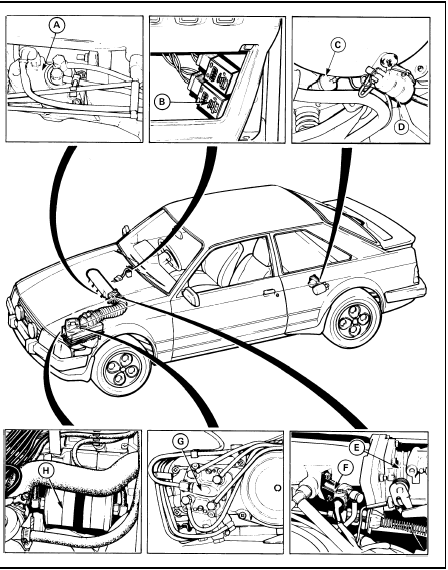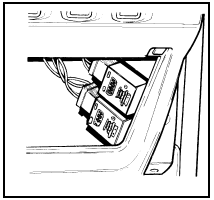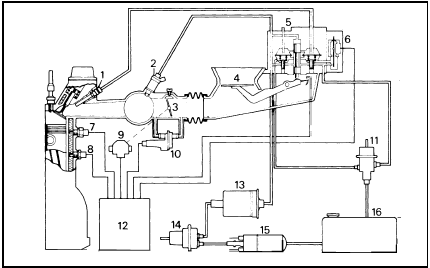General information and precautions
General information The fuel system comprises a centrally mounted fuel tank, electrically-operated fuel pump and Bosch K-Jetronic or KE-Jetronic continuous injection system according to model. The system is used in conjunction with a turbocharger on RS Turbo models.
A more detailed description of the various system components is given in the following paragraphs.
Bosch K-Jetronic system
The Bosch K-Jetronic fuel-injection system
is of the continuous injection type and
supplies a precisely controlled quantity of
atomised fuel to each cylinder under all
operating conditions.
This system, when compared with conventional carburettor arrangements, achieves a more accurate control of the air/fuel mixture resulting in reduced emission levels and improved performance.
The main components of the fuel injection system are as follows (see illustration).

1.5 K-Jetronic system main component locations
A Warm-up regulator
B Speed sensing module
C Fuel accumulator (early model location)
D Fuel pump
E Throttle housing
F Cold start valve
G Fuel distributor
H Fuel filter
a) Fuel tank
b) Fuel pump
c) Fuel accumulator
d) Fuel filter
e) Fuel distributor/mixture control assembly
f) Throttle valve (plate)
g) Injector valves
h) Air box (plenum chamber)
I) Warm-up regulator
j) Auxiliary air device
k) Cold start valve
l) Thermo-time switch
m)Safety module
n) Fuel shut-off valve
o) Speed sensor module
The fuel pump is of electrically-operated,
roller cell type.
The fuel accumulator has two functions, (i) to dampen the pulsation of the fuel flow, generated by the pump and (ii) to maintain fuel pressure after the engine has been switched off. This prevents a vapour lock developing with consequent hot starting problems.
The fuel filter incorporates two paper filter elements to ensure that the fuel reaching the injection system components is completely free from dirt.
The fuel distributor/mixture control assembly. The fuel distributor controls the quantity of fuel being delivered to the engine, ensuring that each cylinder receives the same amount. The mixture control assembly incorporates an air sensor plate and control plunger. The air sensor plate is located in the main airstream between the air cleaner and the throttle butterfly. During idling, the airflow lifts the sensor plate which in turn raises a control plunger which allows fuel to flow past the plunger and out of the metering slits to the injector valves. Increases in engine speed cause increased airflow which raises the control plunger and so admits more fuel.
The throttle valve assembly is mounted in the main air inlet between the mixture control assembly and the air box.
The injector valves are located in the inlet manifold.
The air box is mounted on the top of the engine and functions as an auxiliary inlet manifold directing air from the sensor plate to each individual cylinder.
The warm-up regulator is located on the inlet manifold and incorporates two coil springs, a bi-metal strip and a control pressure valve. The regulator controls the fuel supplied to the control circuit which provides pressure variations to the fuel distributor control plunger. When the coil springs are pushing against the control pressure valve there is a high control pressure and this gives a weak mixture. The coil spring pressure application is controlled by the bi-metal strip which in turn is activated in accordance with engine temperature and an electrical heat coil.
The auxiliary air device is located on the inlet manifold. It consists of a pivoted plate, bi-metal strip and heater coil. The purpose of this device is to supply an increased volume of fuel/air mixture during cold idling.
The start valve system consists of an electrical injector and a thermo-time switch.
Its purpose is to spray fuel into the air box to assist cold starting, the thermo-time switch regulating the amount of fuel injected.
The safety module is located under the facia panel on the driver’s side and is coloured purple (see illustration).

1.16 K-Jetronic system speed sensing module and fuel pump safety module
locations
Its purpose is to shut off the power supply to the fuel pump should the engine stall or the vehicle be involved in an accident. The module senses ignition pulses, and cuts the fuel supply if the ignition pulses stop.
The fuel shut-off valve system is an
economy device whereby air is drawn from
within the air cleaner unit through the shut-off
valve and directed into the ducting chamber
above the air sensor plate causing a
depression. This then causes the sensor plate
to drop which, in turn, shuts off the fuel
supply. The valve is operated by signals from
a coolant temperature sensor and a throttle
position sensor. The shut-off valve will only
operate under the following circumstances:
a) When the engine coolant temperature is
at or above 35°C (95°F)
b) When the throttle is closed and with the
engine speed decelerating from speeds
above 1600 rpm
The engine speed is sensed by a speed
sensing module which is coloured black and
located beneath the facia panel on the driver’s
side.
Bosch KE-Jetronic system The Bosch KE-Jetronic fuel-injection system is fitted to Escort RS Turbo models and is a further development of the K-Jetronic system.
Apart from minor alterations the basic principles of the hydraulics and mechanics used on the K-Jetronic system are unchanged on the KE-Jetronic system. The main difference between the two types is that on the KE-Jetronic system all mixture corrections are controlled electronically by an electromagnetic pressure actuator incorporated in the fuel distributor. The pressure actuator is directly controlled by a variable electric current delivered by the fuel-injection control module.
This module receiver inputs from the various engine sensors concerning engine temperature, engine load, throttle shift, throttle position and starter actuation. This information modifies a program stored in the module memory so that the electromagnetic pressure actuator, on receiving the signal from the module, can alter the mixture to suit all engine operating conditions. This renders the control pressure circuit and warm-up regulator of the K-Jetronic system unnecessary, and also undertakes the functions of the fuel shut-off valve, safety module and speed sensing module (see illustration).

1.19 KE-Jetronic fuel-injection system layout and components
1 Injector
2 Cold start valve
3 Throttle plate
4 Sensor plate
5 Fuel distributor
6 Electro-magnetic pressure actuator
7 Thermo-time switch
8 Temperature sensor
9 Throttle position switch
10 Auxiliary air device
11 Pressure regulator
12 Control module
13 Fuel filter
14 Fuel accumulator
15 Fuel pump
16 Fuel tank
Precautions Due to the complexity of the fuel-injection system, and the need for special tools and test equipment, any work should be limited to the operations described in this Chapter.
Other adjustments and system checks are beyond the scope of most readers and should be left to a Ford dealer.
Before disconnecting any fuel lines, unions or components thoroughly clean the component or connection and the adjacent area.
Place any removed components on a clean surface and cover them with plastic sheet or paper. Do not use fluffy rags for cleaning.
The system operates under pressure at all times and care must be taken when disconnecting fuel lines. Relieve the system pressure as described in the relevant Section before disconnecting any fuel lines under pressure. Refer to the warning note at the end of this Section, and always work with the battery negative lead disconnected and in a well ventilated area.
When working on the KE-Jetronic system
the following additional precautions must be
observed:
a) Never start the engine when the battery is
not firmly connected.
b) Never disconnect the battery when the engine is running.
c) If the battery is to be rapid charged from an external source it should be completely disconnected from the vehicle electrical system.
d) The KE-Jetronic control unit must be removed from the car if temperatures are likely to exceed 80°C (176°F) as would be experienced, for example, in a paint spray oven or if any electric welding is being carried out on the car.
e) The ignition must be switched off when removing the control unit.
Warning: Many of the procedures in this Chapter entail the removal of fuel pipes and connections which may result in some fuel spillage. Before carrying out any operation on the fuel system refer to the precautions given in Safety First! at the beginning of this manual and follow them implicitly.
Petrol is a highly dangerous and volatile liquid and the precautions necessary when handling it cannot be overstressed
See also:
Boot lid (Saloon models) - removal and refitting
Removal
1 Open the boot lid, and place protective
covers (old rags or cardboard) beneath the
corners of the lid, and over the rear wings to
prevent damage to the paintwork.
2 Where applicable, di ...
Oil pump - removal and refitting
Note: A suitable puller will be required to
remove the crankshaft pulley. A new
crankshaft pulley bolt, a new lower timing
chain cover gasket, and a new oil pump
gasket, must be used on refitting. ...
Starter motor - testing in the car
Note: Refer to the precautions given in
“Safety first!” and in Section 1 of this Chapter
before proceeding.
1 If the starter motor fails to operate when the
ignition key is turned to the appropria ...
